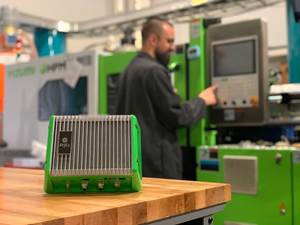Next Generation Plastics Workforce
After years of closely monitoring an increasingly worrisome labor shortage, the Plastics Industry Association’s warnings about the widening gap between the sector’s need for skilled workers and the supply of such employees have shifted to full alarm. The association calls for “collaborative response across all levels of government and all manufacturing sectors” to tackle this critical issue.
After years of closely monitoring an increasingly worrisome labor shortage, the Plastics Industry Association’s (PLASTICS) warnings about the widening gap between the sector’s need for skilled workers and the supply of such employees have shifted to full alarm. As stated in PLASTICS’ 2017 Size & Impact Study, “While the skills gap and the decline of a qualified manufacturing workforce have been discussed for many years now, the nation has reached the point where their impacts will begin to be felt more acutely.”
In that report, released in December, PLASTICS forecasts that employment in plastics manufacturing will expand 0.9 percent, 0.7 percent and 0.6 percent from 2017 to 2019—rates slower than in the three prior years and in five of the last six going back to 2011. Total employment in 2019 is forecast to reach 735,000, not including captive operations. It stands at 719,000 today. “Employment growth slows as the supply of labor starts to dry up,” is how PLASTICS describes the impending scenario in the report.
Plastics is not alone in its search for workers. According to the Manufacturing Institute, 3.5 million manufacturing jobs will need to be filled in the next decade, but 2 million of those will remain vacant, as economic expansion and the retirement of Baby Boomers stoke a self-sustaining fire. According to the Institute’s most recent survey, 35 percent of respondents believe a shortage of skilled workers will be the top impediment to growth next year.
In its report, PLASTICS calls for a “collaborative response across all levels of government and all manufacturing sectors,” including a shift in how new employees are created.
“The U.S. must do a better job of training workers to fill the jobs that are available today and will be available tomorrow, rather than training workers for the jobs America formerly possessed,” the report states.
The plastics industry has responded at the university level with shifting curricula and new learning formats, including online education; and at the processor level with unique programs that target everyone from engineers who had no introduction to plastics while in school, to people who’ve had no introduction to engineering or plastics, period.
The Long View
Robert Malloy has been helping train plastics industry workers at the university level for more than 30 years. Malloy joined the faculty of the University of Massachusetts–Lowell’s plastics engineering program in 1985, eventually becoming program chair, before transitioning to a professor emeritus at the school. Malloy first came on campus at Lowell 40 years ago as an undergraduate student, and in the intervening years he’s seen both change and stasis in how students are readied to work in plastics. However, the demand for trained people, while it has ebbed and flowed somewhat, has remained constant.
“Education is like a pipeline,” Malloy says, “and it takes four or five years for a student to pass through our program. So while the demand is there today, the student that’s coming here today isn’t going to graduate for four or five years. So there’s this lag time where the work force just takes a while to generate.”
David Kazmer, current chair of UMass Lowell’s plastics program, noted that the pipeline coming from his school is full, with enrollments currently at an all-time high. At the previous peak in the 1970s, Kazmer said approximately 50 to 60 students would graduate annually. The largest classes today—freshmen and junior years—have 75 students each, with approximately 340 total across the program.
Kazmer said that job placement for those students is the best across all of UMass Lowell, with graduates signing on everywhere from Apple, Tesla, and General Electric to Berry Plastics, Milacron, Wittmann Battenfeld, and more. Over the last six years, in fact, UMass Lowell plastics engineering grads have gone to 110 different companies.
UMass Lowell has some company in offering a plastics engineering program, but compared with other disciplines, the number of plastics options in academia is disproportionately small relative to the number of people who eventually have to work with these materials.
Online university database Cappex lists 13 schools with a polymer/plastics engineering major (although its list omits some well-known programs, including Ferris State and Pittsburg State). Across the U.S., only four of those have ABET (Accreditation Board for Engineering Technology) accreditation: UMass Lowell, University of Wisconsin Stout, Penn State Behrend, and Pittsburg State University.
These programs will feed a constant, if small, stream of qualified people into the plastics pipeline; but for Malloy and others, the flow could be greatly increased if related programs, particularly mechanical engineering, gave more than passing attention to plastics in their courses. In addition to his work at UMass Lowell, Malloy provides plastics training at corporations, where he sees this gap in many engineers’ education first-hand.
“I always wonder, ‘Why aren’t they doing more in plastics?’” Malloy said. “I ask these mechanical engineers when I teach a course at a company, ‘What did you do in plastics education? How much plastics education did you have?’ And it’s always very little. I don’t understand how they can be designers of plastic parts if they haven’t had any courses in chemistry, plastic materials, or manufacturing of plastics.”
Meeting an Industry Need
In 2015, appreciating the need to help people in industry working with plastics that were not educated in plastics, the American Injection Molding Institute (AIM) was created by Beaumont Technologies, Inc., Erie, Pa. (beaumontinc.com). David Hoffman, director/instructor, Plastics Education & Training at AIM, says that since that time, 63 students have graduated from its Plastics Technology & Engineering (PTE) Certificate program, which received ANSI accreditation this past December, with three more classes currently in progress. Helpful, no doubt, but a drop in the proverbial bucket compared with what’s needed, Hoffmann says: “If you look at the number of people who graduate from plastics engineering or plastics technology programs in the U.S. every year, it’s in the hundreds, and demand for engineering and technologists in the industry is huge.”
By contrast, in 2015, 35,730 mechanical engineering degrees were awarded in the U.S., according to DataUSA. How many of those people know polyethylene from polypropylene? Like Malloy, Hoffman does his own survey of AIM’s students—and gets similar results. “We take an informal poll in every class,” Hoffman says. “We ask, ‘How many people have actually gone to school for plastics?’ Rarely do people raise their hands, and yet, these people are working in the plastics industry, and nobody has told them anything about this stuff.”
Instructor Gap
The good news for the industry is that at the university level, interest in plastics engineering is extremely strong. The bad news: Schools are starving for qualified instructors, particularly those with knowledge of processing. “Finding faculty that have that blend of theory and practice is really a limiting factor,” Kazmer says.
“Finding teachers is a very significant challenge,” Malloy agrees. “Getting students these days, with the demand for graduates, is not a problem, but getting qualified faculty is a problem and it’s not just a matter of salary.” Here again, the lack of plastics-specific coursework in U.S. engineering programs poses a challenge.
“There are very few universities in the United States that have high-level programs in plastics processing,” Malloy notes, pushing UMass Lowell to look abroad to fill its faculty. “Some of our best candidates come from overseas simply because many foreign countries seem to have a better overall plastics education system.”
Fulfilling the need for teachers, and upgrading the plastics content of engineering curricula—two industry challenges that require one thing: time.
“Education doesn’t come quick—it’s not a magic pill,” Hoffman says. “It’s not something where you’re going to go to a course for a week or whatever and know everything. It takes time, and I think that’s one of the biggest challenges for this industry. Everyone wants a quick fix for education—well, there isn’t one.”
Related Content
Global Show, Global Training
Visitors to RJG’s K 2022 booth can watch training segments from each of its global offices in the RJG Theater, as well as get hands-on demos of its CoPilot process control and Hub networking devices.
Read MoreStrategic Workforce Management Supports the Moldmaking Industry
NPE2024: Kruse presents its workforce management framework for optimized organization and management of human resources.
Read MoreShawnee State University’s Plastics Engineering Program Earns Accreditation
The Accreditation Board for Engineering & Technology certification makes the university’s program one of just four bachelor’s programs in the world with this designation and the only program of its kind in the state of Ohio.
Read MoreTAPPI to Provide Film Education Program at PTXPO 2023
Second-ever PTXPO will feature a robust education program on flexible film, with more technical programming in the works.
Read MoreRead Next
Lead the Conversation, Change the Conversation
Coverage of single-use plastics can be both misleading and demoralizing. Here are 10 tips for changing the perception of the plastics industry at your company and in your community.
Read MorePeople 4.0 – How to Get Buy-In from Your Staff for Industry 4.0 Systems
Implementing a production monitoring system as the foundation of a ‘smart factory’ is about integrating people with new technology as much as it is about integrating machines and computers. Here are tips from a company that has gone through the process.
Read More




























